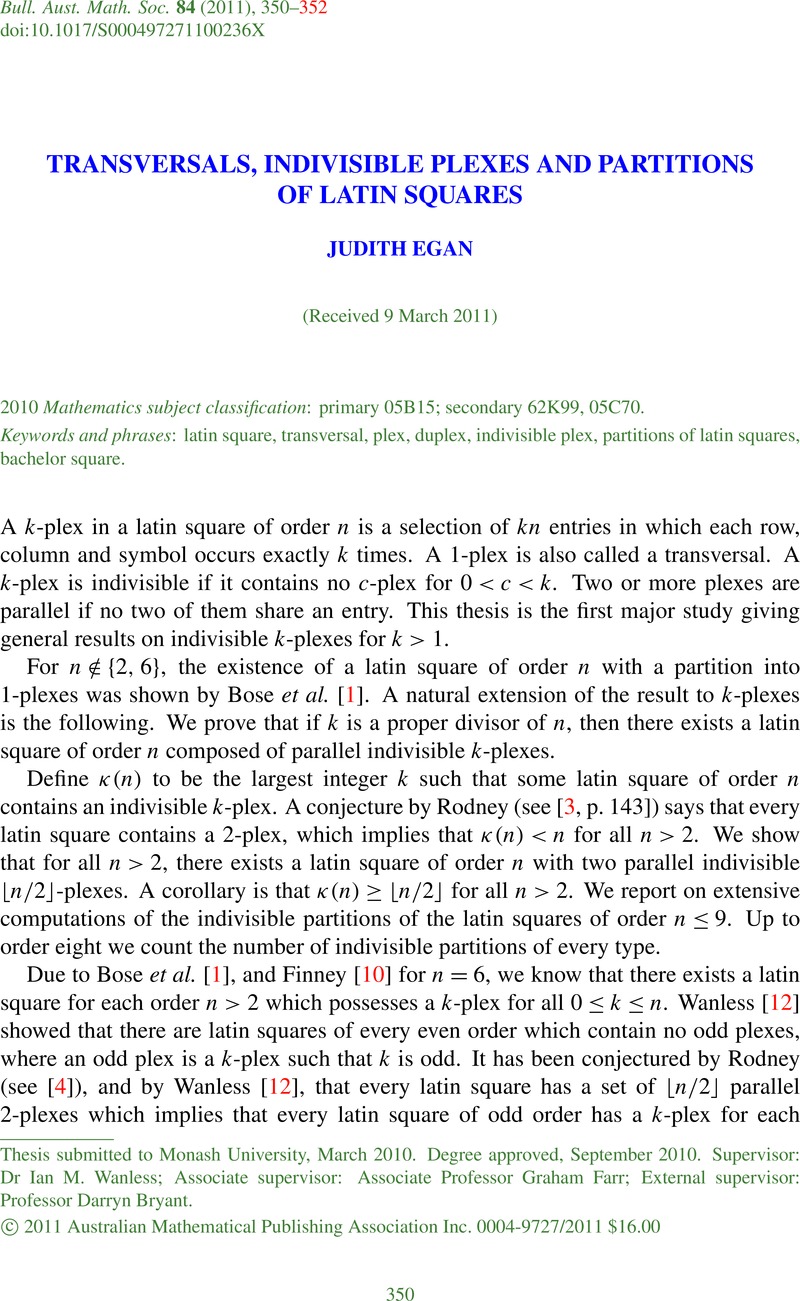No CrossRef data available.
Article contents
TRANSVERSALS, INDIVISIBLE PLEXES AND PARTITIONS OF LATIN SQUARES
Published online by Cambridge University Press: 16 June 2011
Abstract
An abstract is not available for this content so a preview has been provided. As you have access to this content, a full PDF is available via the ‘Save PDF’ action button.

Keywords
MSC classification
- Type
- Abstracts of Australasian PhD Theses
- Information
- Bulletin of the Australian Mathematical Society , Volume 84 , Issue 2 , October 2011 , pp. 350 - 352
- Copyright
- Copyright © Australian Mathematical Publishing Association Inc. 2011
References
[1]Bose, R. C., Shrikhande, S. S. and Parker, E. T., ‘Further results on the construction of mutually orthogonal latin squares and the falsity of Euler’s conjecture’, Canad. J. Math. 12 (1960), 189–203.CrossRefGoogle Scholar
[2]Bryant, D., Egan, J., Maenhaut, B. and Wanless, I. M., ‘Indivisible plexes in latin squares’, Des. Codes Cryptogr. 52 (2009), 93–105.CrossRefGoogle Scholar
[3]Colbourn, C. J. and Dinitz, J. H. (eds), Handbook of Combinatorial Designs, 2nd edn (Chapman & Hall/CRC, Boca Raton, FL, 2007).Google Scholar
[4]Dougherty, S. T., ‘Planes, nets and codes’, Math. J. Okayama Univ. 38 (1996), 123–143.Google Scholar
[5]Egan, J., ‘Bachelor latin squares with large indivisible plexes’. J. Combin. Des., to appear.Google Scholar
[6]Egan, J. and Wanless, I. M., ‘Latin squares with restricted transversals’, Preprint.Google Scholar
[7]Egan, J. and Wanless, I. M., ‘Latin squares with no small odd plexes’, J. Combin. Des. 16 (2008), 477–492.CrossRefGoogle Scholar
[8]Egan, J. and Wanless, I. M., ‘Indivisible partitions of latin squares’, J. Statist. Plann. Inference 141 (2011), 402–417.CrossRefGoogle Scholar
[9]Evans, A. B., ‘Latin squares without orthogonal mates’, Des. Codes Cryptogr. 40 (2006), 121–130.CrossRefGoogle Scholar
[10]Finney, D. J., ‘Orthogonal partitions of the 6×6 latin squares’, Ann. Eugenics. 13 (1946), 184–196.CrossRefGoogle Scholar
[11]Ryser, H. J., ‘Neuere Probleme der Kombinatorik’, Vortrage über Kombinatorik Oberwolfach (1967), 69–91.Google Scholar
[12]Wanless, I. M., ‘A generalisation of transversals for latin squares’, Electron. J. Combin. 9 (2002), R12.CrossRefGoogle Scholar
[13]Wanless, I. M. and Webb, B. S., ‘The existence of latin squares without orthogonal mates’, Des. Codes Cryptogr. 40 (2006), 131–135.CrossRefGoogle Scholar


